Back pain due to sedentary work: causes and tips
80% of the population suffers from back pain at some point in their lives. In many cases, back problems are caused by too little movement and long periods of sitting in an incorrect posture. Back pain due to sedentary work is common. Read in this blog how exactly these back problems occur and what you can do about them. We start by giving you some more information about the way the back works and demonstrate subsequently how your posture may impact on this.
What is an intervertebral disc?
An intervertebral disc is a padding between two separate vertebrae. It consists of a jelly-like core surrounded by fibrous cartilage. Due to their structure, intervertebral discs are stretchy and work as a type of shock absorber. The intevertebral discs absorb the impact and the pressure on the vertebrae during daily activities and physical loads. The intevertebral discs lose some fluid each time due to the pressure but recover spontaneously during sleep when pressure on the back is minimal.
How do intervertebral discs work?
The back consists of vertebrae that jointly make up the spine. The intervertebral discs protect the back together with the ligaments and the muscles surrounding the vertebrae. Despite the strong structure, more than 80% of the population still get back problems. Of all back problems, 90% results from the intervertebral discs.
In order to understand most of the back problems, you only have to understand the working of these intervertebral discs. They consist of a core of fluid surrounded by strong bands, which makes them a perfect spring system. The bands are tensed by the forces in the core and by bending movements. These bands are heavily loaded when you are bending, sitting, lifting and during some abdominal muscle exercises that are not to be recommended.
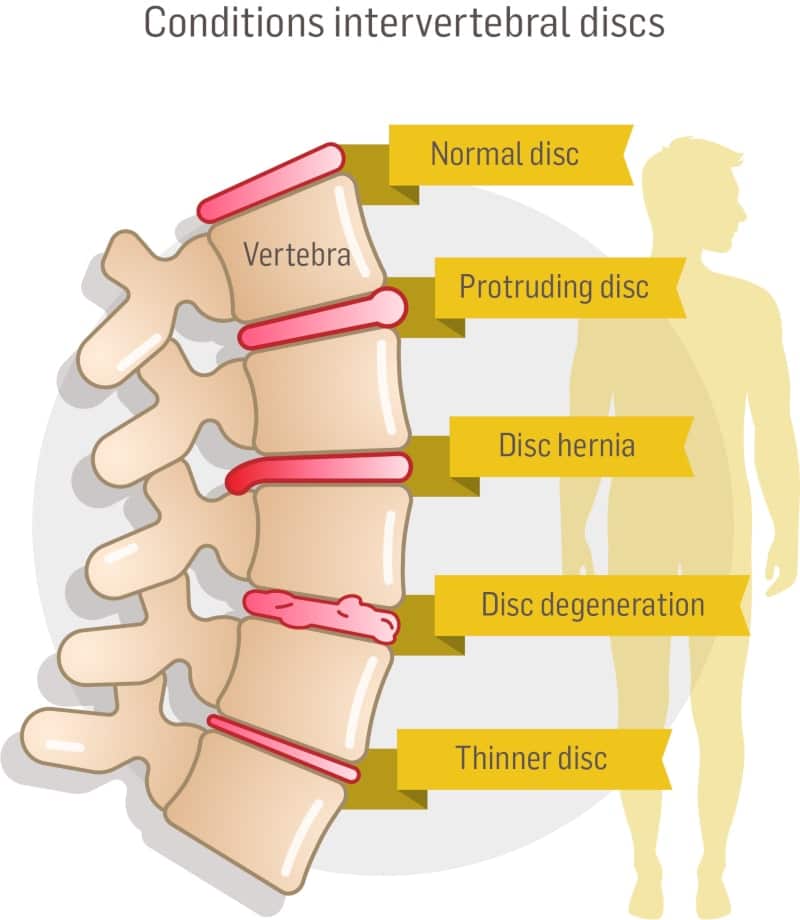
Impact of our posture on back problems
Physique, mental condition or age are not the only factors that determine whether you suffer from back pain. The posture profile plays a part as well. Adopting a correct posture is an easy and very important way to keep body and mind healthy. It does not only ensure a better appearance, but also fewer back problems. If we do not pay attention to our posture, this may cause back problems and early wear of the intervertebral discs. An incorrect posture puts considerable strain on the spine, the shoulders and the knees.
60% of the people who lean forward with their heads, will (later) experience pain in their lower backs. A hollow lower back causes back problems as well, but to a somewhat lesser extent. In the spoon posture, the upper back is round, but the back is straight. This posture puts less strain on the lower back. It is best to have a normal, correct posture. Corrective exercises of the posture taught by a therapist may prevent or cure back problems.
A correct posture also improves breathing and circulation and reduces strain on the joints and back. The forces and the load on the body are then evenly divided across the body. A correct posture respects the natural curve of the back. Therefore, always hold the breast somewhat forward, sit or stand straight up and pull in the stomach. This ensures a nice straight back. Keep the shoulders low and the chin somewhat up, so that the head is in one straight line with the body. This requires some exercise, in particular when muscles have weakened.
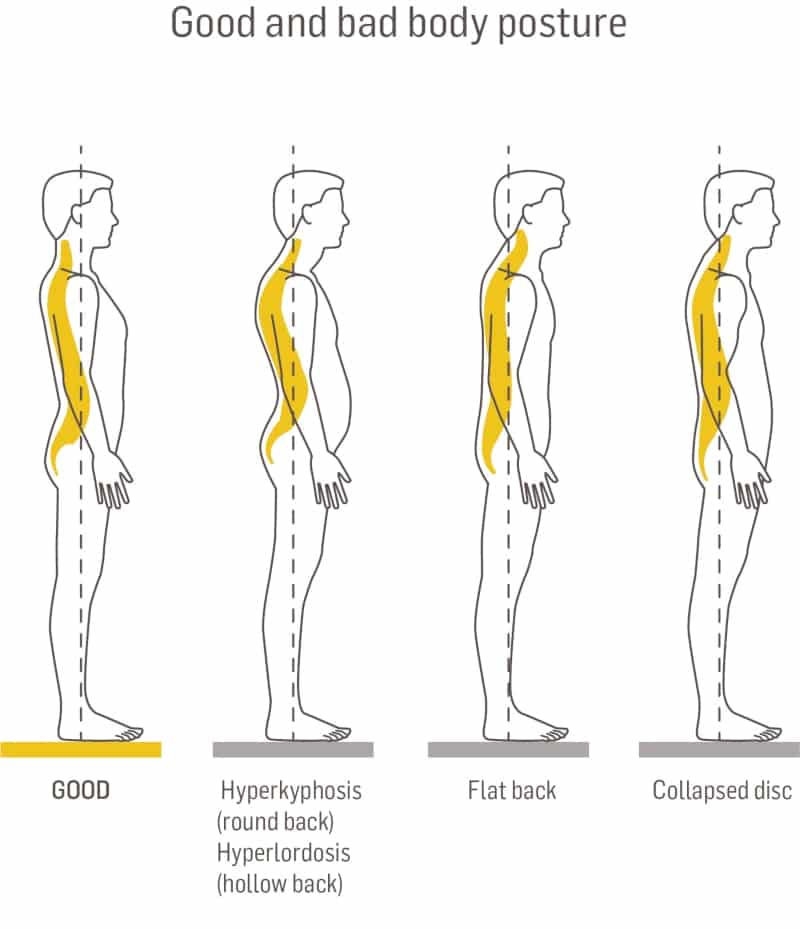
By adopting a correct posture, you automatically tighten the back and abdominal muscles. They form a ‘protective’ corset around the spine, when you are sitting and moving, and during strain. When we have strongly developed abdominal, leg and back muscles, they will absorb part of the load, so that the back gets extra protection during strain. Therefore, it is important to train the back and abdominal muscles.
Use the legs instead of the back. Bend the legs and keep the back straight when you want to pick something up for instance. Spread the legs if you do work standing up and support yourself by placing your hip against a work surface. Not sure about all of this? Seek help from a physiotherapist.
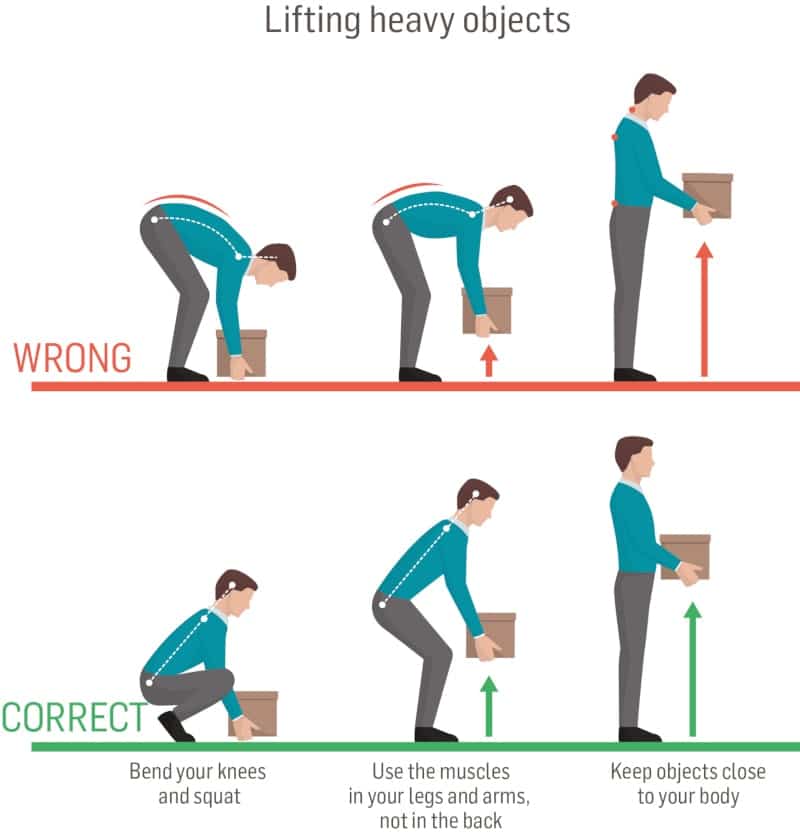
Research into back problems and posture
Professor Van Deursen conducted a study in 2000 of how spinal loads occur during various postures. If we look at the action of the spring system in the intervertebral discs, we can properly analyse the spinal load in our daily live.
Our posture clearly plays an important role. An incorrect posture increases spinal load and can result in faster wear and tear. That is a fact. But in addition to an incorrect posture, daily ‘normal’ postures may have a specific impact on the strain on the intervertebral discs:
- When we lie on our back, the load (spinal load, determined by the weight of our body on the one hand and our muscles – that remove the load from the vertebrae when they tense – on the other hand) is minimal, i.e. 25%. When we lie on our side, the load increased to no less than 75%.
- When we are standing up straight, the loads that affect the intervertebral disc are limited and only slightly higher than when we are lying on our side, provided we adopt a nice straight posture.
- In a standing posture the vertebrae of our lower back are loaded 100%.
- When we sit, the load is highest and forces can affect the intervertebral discs that are 4 times higher than when we are lying on our back. This may even increase to 140% to 185% depending on the type of chair, with or without backrest. The same high load applies to bending and doing sit-ups. During lifting and raising objects, the forces can increase even further.
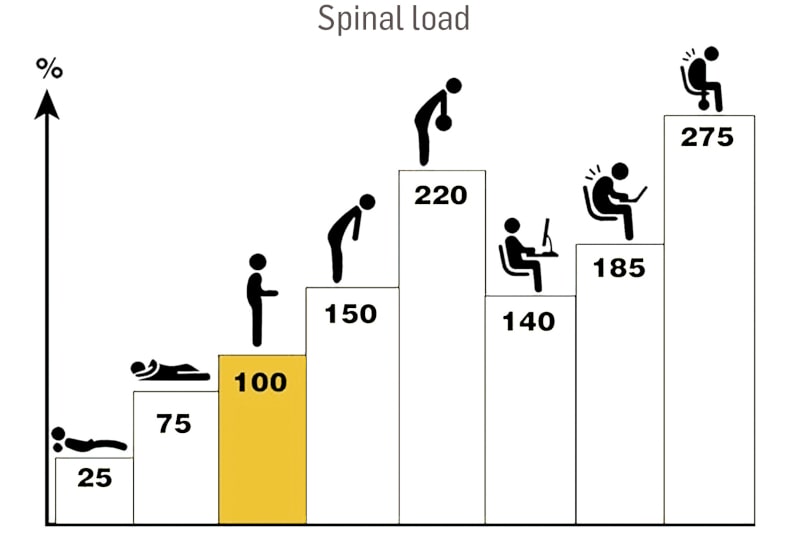
Causes of back pain due to sedentary work
So, back problems are often the result of too little movement or sport, resulting in weak muscles. Sitting a lot at work, every day, is physically very stressful because the seated position as such already causes a spinal load. Often, a sedentary profession is underestimated as the cause of back problems. However, this is gradually changing, and sitting is referred to as “the new smoking”, as sitting too much also increases the risk of diabetes type 2, even in people that are physically fit.
Sitting for long periods is an important risk factor for developing back problems at an early age. Sitting as such is a physically straining position for the spine and is often underestimated.
In a seated position, the lower vertebrae experience more strain than in a standing position. This causes more strain on the intervertebral discs. An intervertebral disc works as a watery sponge that protects the vertebrae during physical strain. When there are insufficient changes in seating positions, these intervertebral discs will lose their loading capabilities so that the load on the vertebrae increases. This can result in back pain in the short term and in arthrosis in the long term.
There are two ways to do sedentary work: the active and passive seating position. In an active seating position, you are concentrated and are sitting on the edge of your chair. You do not use the back rest but are tilting somewhat forward with a hollow back. This is really a correct posture, because the back muscles are nicely tensed, and the spinal load is reduced in this way. However, the posture cannot be maintained for long periods. Therefore, after a while, you will unconsciously change to a passive seating position, leaning backwards. This seems comfortable, but the pressure on the intervertebral discs increases and there is strain on the back muscles causing pain in the lower back quite quickly.
Try to alternate with an active seating position that is good for back and abdominal muscles and a correct passive seating position, where you can work properly supported at the right seating height. Also get up regularly to walk around. It will improve your work as well.
Tips to prevent back pain due to sedentary work
Do you have a sedentary job? These tips will help you to prevent back problems:
- A good office chair with a curve in the lower back is important. With this type of chair, the back rest (lower back hollower) and the seat rest (pelvis tilted backwards) can be adjusted. Do you not have the perfect chair? A seat cushion, a wedge cushion or a waist cushion can work wonders.
- Also use the backrest to properly support the lower back. Therefore, always sit backwards in your chair. With an ergonomic chair, the depth of the backrest is adjustable.
- To relax the neck, you make sure that the computer screen is somewhat higher than the work surface, so that you do not have to look down.
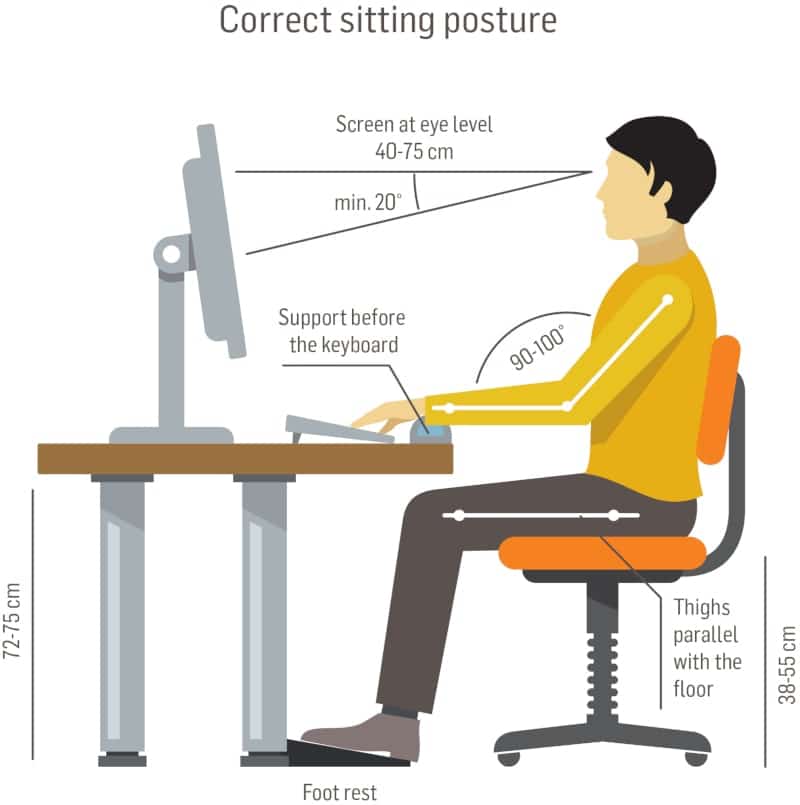
- Sitting still for very long periods is detrimental. Make your back hollow regularly when you are sitting and move when this is possible. For instance, alternate a sitting with a standing posture and walk around once and a while. Many problems start because the lower back is strained too long in a bent position and its position is not changed often enough.
- Alternating between sitting and standing is therefore good. A high-low desk (or sitting-standing desk) is the ultimate piece of furniture for this. You must have some discipline, but that aside.
- Strong back and abdominal muscles form a natural corset around the spine. They protect the spine against overloading but also ensure that the back is less strained.
- Twisting and bending movements cause spinal load. In particular if they happen at the same time or are often repeated. Therefore, avoid these movements. If you want to pick something up or take something that is somewhat removed from you or behind you, get up. Bent your knees and save your back.


